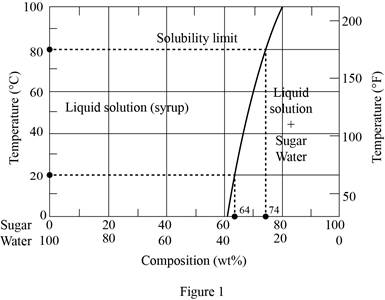
(a)
The amount of sugar dissolve in
(a)
Answer to Problem 1QP
The amount of sugar dissolve in
Explanation of Solution
Given:
The amount of water,
The temperature for dissolving of sugar into water,
Explanation:
Express the amount of sugar.
Here, mass of sugar is
Conclusion:
Refer Figure 9.1, "the solubility of sugar in sugar water syrup" and show the concentration of sugar at temperature of

From Figure (1), write the concentration of sugar at temperature of
Substitute
Hence, the amount of sugar dissolve in
(b)
The composition of the saturated liquid solution (in wt% sugar) at
(b)
Answer to Problem 1QP
The composition of the saturated liquid solution (in wt% sugar) at
Explanation of Solution
Given:
The temperature for dissolving of sugar into water,
Explanation:
From Figure (1), write the concentration of sugar at temperature of
Hence, the composition of the saturated liquid solution (in wt% sugar) at
(c)
The amount of solid sugar will come out of solution upon cooling at
(c)
Answer to Problem 1QP
The amount of solid sugar will come out of solution upon cooling at
Explanation of Solution
Given:
The temperature for dissolving of sugar into water,
Explanation:
Express the concentration of sugar at
Here, mass of sugar is
Express the amount of solid sugar will come out of solution upon cooling at
Conclusion:
Substitute
Substitute
Hence, the amount of solid sugar will come out of solution upon cooling at
Want to see more full solutions like this?
Chapter 10 Solutions
FUND MAT SCI+ENG ACCESS+EPUB
- show all the workarrow_forward1. In the following closed-loop system, a PD controller of the form K(s + 5) is used. Design the gain K such that the system achieves an overshoot of 16%. Calculate the settling time and peak time for the PD controlled system. Compensator R(s) + E(s) Plant 1 C(s) K(s+Zc) (s+1)(s+2)(s+5)arrow_forwardshow all the workarrow_forward
- 3. Use MATLAB to generate the Nyquist plot for the following system. Then, apply the Nyquist stability criterion to determine the range of K values that ensure the stability of the closed-loop system. R(s)+ K C(s) (s+2) 1 (s + 4)(s+6)arrow_forwardhand-written solutions only, please.arrow_forward4. Please find the stability margins from the following Bode diagrams. Bode Diagram Phase (deg) Magnitude (dB) 50 -100 -90 -135 -180 -270 10" 10° Frequency (rad/sec) 10'arrow_forward
- 2. Please use asymptotes to draw the Bode diagrams of the following transfer function. Please label the axes to show the cut-off frequencies and key values on vertical axes and label each asymptote with its slope. G(s) s+10 s(s²+10s+100)arrow_forwardFind Voarrow_forwardA farm of 40 hectares is supplied by open field drains. The spacing of these drains were selected to be 100m and the length of each drain is 600 m. If the drainage coefficient is 4 cm/day, find: 1- Discharge at the end of a field drain. 2- Total discharge passed through the collector drain. 3- The dimension of open drains, if n= 0.03, S= 0.00035 and Z= 1.5arrow_forward
 MATLAB: An Introduction with ApplicationsEngineeringISBN:9781119256830Author:Amos GilatPublisher:John Wiley & Sons Inc
MATLAB: An Introduction with ApplicationsEngineeringISBN:9781119256830Author:Amos GilatPublisher:John Wiley & Sons Inc Essentials Of Materials Science And EngineeringEngineeringISBN:9781337385497Author:WRIGHT, Wendelin J.Publisher:Cengage,
Essentials Of Materials Science And EngineeringEngineeringISBN:9781337385497Author:WRIGHT, Wendelin J.Publisher:Cengage, Industrial Motor ControlEngineeringISBN:9781133691808Author:Stephen HermanPublisher:Cengage Learning
Industrial Motor ControlEngineeringISBN:9781133691808Author:Stephen HermanPublisher:Cengage Learning Basics Of Engineering EconomyEngineeringISBN:9780073376356Author:Leland Blank, Anthony TarquinPublisher:MCGRAW-HILL HIGHER EDUCATION
Basics Of Engineering EconomyEngineeringISBN:9780073376356Author:Leland Blank, Anthony TarquinPublisher:MCGRAW-HILL HIGHER EDUCATION Structural Steel Design (6th Edition)EngineeringISBN:9780134589657Author:Jack C. McCormac, Stephen F. CsernakPublisher:PEARSON
Structural Steel Design (6th Edition)EngineeringISBN:9780134589657Author:Jack C. McCormac, Stephen F. CsernakPublisher:PEARSON Fundamentals of Materials Science and Engineering...EngineeringISBN:9781119175483Author:William D. Callister Jr., David G. RethwischPublisher:WILEY
Fundamentals of Materials Science and Engineering...EngineeringISBN:9781119175483Author:William D. Callister Jr., David G. RethwischPublisher:WILEY





